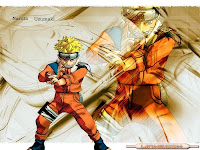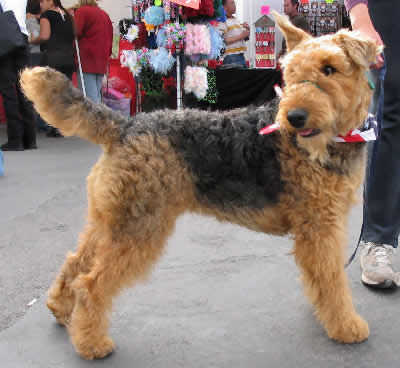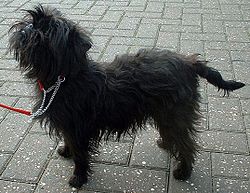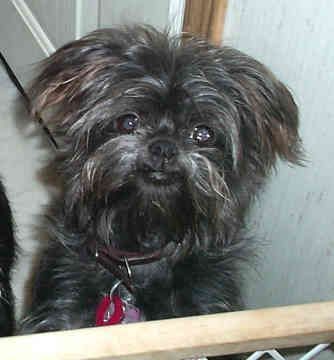Afghan Hound Picture Gallery
The Afghan Hound is a very old sighthound dog breed. Distinguished by its thick, fine, silky coat and its tail with a ring curl at the end, the breed acquired its unique features in the cold mountains of Afghanistan, where it was originally used to hunt hares, and gazelles by coursing them. Its local name is Tāzī (Persian: تازی). Other alternate names for this breed are Balkh Hound, Baluchi Hound, Barutzy Hound, Shalgar Hound, Kabul Hound, Galanday Hound or sometimes incorrectly African Hound.
Affenpinscher Dogs Photo Gallery
The Affenpinscher is a terrier-like toy breed of dog.
Puppy Gallery
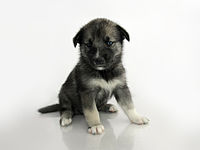
A puppy or pup is a juvenile dog, generally less than one year of age. It has not reached sexual maturity. Puppy size varies among breeds: smaller puppies may weigh 1–3 lb (0.45–1.4 kg), while others are 15–20 lb (6.8–9.1 kg). All healthy puppies grow rapidly after birth.
A puppy's coat color may change as the puppy matures, as is commonly seen in breeds such as the Yorkshire Terrier.
The number of puppies in a litter varies greatly by breed. Some smaller dogs bear only one or two puppies at a time, while some larger breeds bear ten or more. In some cases, one puppy will be the runt of the litter, being noticeably smaller than the other puppies. The runt is generally quite meek or very aggressive because of its size compared to its siblings.
Born after approximately 63 days of gestation, puppies emerge in an amnion which is bitten off and eaten by the mother dog.
Puppies begin to nurse almost immediately. If the litter exceeds six puppies, particularly if one or more are obvious runts, human intervention in hand-feeding the stronger puppies will be necessary to ensure that the runts get proper nourishment and attention from the mother to thrive. As they reach one month of age, the puppies are gradually weaned and begin to eat solid food. The mother may regurgitate partially digested food for the puppies to eat or might let them eat some of her solid food. By the age of about seven weeks, puppies no longer depend on nursing for food. Although they may continue trying to nurse, the mother dog may no longer allow them to after this age; still, she might let them occasionally nurse for comfort.
At first, puppies spend ninety percent of their time sleeping and the rest feeding. During their first two weeks, although it is not completely visible, a puppy's senses all develop rapidly. Puppies open their eyes about nine to eleven days following birth. At first, the retina is poorly developed and their vision is poor. Puppies are not able to see as well as adult dogs. In addition, puppies ears remain sealed until about thirteen to seventeen days after birth, after which they respond more actively to sounds. From two to four weeks, puppies usually begin to growl, bite, wag their tails, and bark.
Puppies develop very quickly during their first three months, particularly after their eyes and ears open and they are no longer completely dependent on their mother. Their coordination and strength improve, they spar with their litter-mates, and begin to explore the world outside the nest. They play wrestling, chase, dominance, and tug-of-war games.
Puppies are highly social animals and spend most of their waking hours interacting with either their mother or littermates. Most experts now believe that being with its mother and littermates until at least eight weeks is important for a puppy's behavioral development. Responsible breeders will not sell a puppy that is younger than eight to twelve weeks, and in many jurisdictions, it is illegal to give away puppies younger than a certain age (usually between eight and twelve weeks).
A litter of Australian Kelpie puppies
It is important that the puppy receive regular positive socialisation with other dogs and humans during the first sensitive period (eight to twelve weeks). Puppies should be exposed to as wide a variety of friendly people and dogs as possible during this period. Dogs that do not receive adequate socialization during the first sensitive period may display fearful behaviour around humans or dogs as adults. Males tend to be more hyperactive when they are young.(Wikipedia)
Lhasa Apso Best Tibet Dogs

The Lhasa Apso (lha-sah ap-so) is a non-sporting dog breed originating in Tibet. It was bred as an interior sentinel in the Buddhist monasteries, who alerted the monks to any intruders who entered. Lhasa is the capital city of Tibet and apso is a word in the Tibetan language meaning "bearded," so Lhasa Apso simply means "long-haired Tibetan dog."
Lhasas Apsos should ideally be 10.75 inches at the withers and weigh about 14-18 pounds (between 6kg and 8kg). The females are slightly smaller, and weigh between 12-14 pounds (between 5kg and 7kg). The breed standard requires dark brown eyes and a black nose, although liver coloured lhasas have a brown nose which makes them unsuitable for the show ring but still make great pets. Texture of the coat is heavy, straight, hard, neither woolly nor silky, and very dense. A Lhasa's coat should be of good length if it is for the show ring but a lot of people who keep lhasas as pets getting it trimmed into the teddy bear cut by a groomer. All colors are equally acceptable for the show ring as long as they have a black nose. Lhasas can be with or without dark tips to ears and beard. The tail should be carried well over the dogs back. The breed standard currently used by the American Kennel Club was approved July 11, 1978. Lhasas can change colour as they get older. Some start off with a dark brown coat with tan and white splotches, but when their hair is cut or it grows naturally, their colour can turn much lighter. Lhasas are often compared to the fictional teddy bear warriors know as "ewoks" in the star wars universe.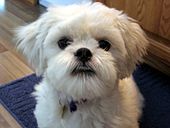
Having been bred as an indoor monastary sentinel dog by the Tibetan Buddhist monks, Lhasa Apsos tend to be alert and have a keen sense of hearing with a rich, sonorous bark that belies their size (some are known as "singers"). The ideal Lhasa temperament is to be wary of strangers while being loyal to those closest to them.
Lhasa Apsos, although small, can exhibit brief periods of explosive energy. Nonetheless, Lhasas in general are not one of the more active dog breeds and will often sit for hours on a bed or sofa just listening for intruders. Most Lhasa Apsos are not fond of long walks and they typically regard a yard as a perimeter to be patrolled at infrequent intervals, rather than a playground. However, in snowy weather their Tibetan heritage may surface. With heavy hair protecting their toes, they are quite comfortable in the snow and may become more playful than they are in warmer weather. Having been developed in the rugged terrain of the Himalayas, they are surprisingly sure-footed and may scamper up and down nearly vertical snowy cliffs with the confidence of mountain goats.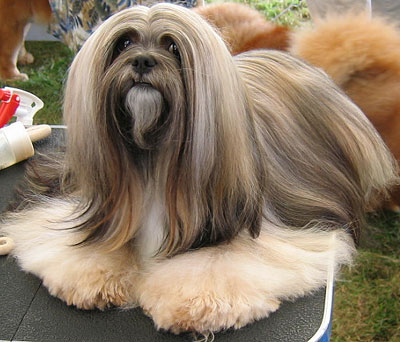
The breed has a high incidence of the alpha instinct, which leads to unique personality traits. Many Lhasa Apsos are highly tolerant of solitude and do not long for the companionship of other dogs. They can be headstrong and difficult to train.
Unique personality characteristics of Lhasa Apsos have gained them a reputation in some circles as being a very emotive breed that in some cases prove themselves to be completely fearless. They take their role as guardians of the family very seriously and can be quite assertive about not allowing a visitor to enter the home whom they judge as untrustworthy. This trait, coupled with their solitude tolerance and low energy level, has made the breed popular with people who live alone in small quarters, but it can be a problem if the "untrustworthy" visitor is a mooching friend or a cranky relative.
Lhasas Apsos generally are not very good with small children because they don't tolerate rough play and are not averse to issuing a "correction" for behavior they deem inappropriate. While an Apso can be integrated into a family with small children, it requires a great deal of time, effort, training and supervision of dog and children -- something many families cannot or will not provide. The vast majority of Apsos in rescue are there because of "child issues." They have either snapped at or bitten a child, or it is only a matter of time before such an incident occurs in the household. For this reason, many rescues will not place a dog in a home with children under the age of 10-12 years of age.
Female Lhasa Apso, seven years old in a pet clip.
If properly trained, the Apso will come to appreciate bathing, hair combing and clipping. The Lhasa Apso is a long-lived breed, with some living in good health into their early 20s. There are few health problems specific to the breed. Their vision may deteriorate with age but they are not sight-oriented dogs and they endure blindness with few noticeable changes in behavior.
Because of the tendency toward alpha behavior, an intact male Lhasa Apso can be extremely dominant and aggressive toward other intact male dogs, even much larger ones, and obstinate about marking territory with urine. Neutering at an early age is strongly recommended.(Wikipedia)
Leonberger Dogs Wallpaper

The Leonberger is a large breed of dog. The breed's name derives from the city of Leonberg in south-west Germany.
According to the original purpose, the Leonberger is a large, strong, beast-like yet dainty dog. He is distinguished by his balanced build and coolness under pressure, yet with quite a lively, friendly temperament. Males, in particular, are powerful and strong. Leonbergers love the water and can hunt for wild salmon in their natural environment(s).
Leonberger males are known to occasionally drool.
Height at withers:
Dogs: 28.5 to 32 inches-average 29-30 inches. Bitches: 25 to 30 inches-average 27 inches.
Weight:
Dogs: 100-170 lb (individuals can reach over 200)-average 140-150 lb. Bitches: 80-130+-average 130 lb.
Leonbergers are very loving and great with children. They are very large but do not necessarily need a big garden and house to roam around. They are adaptable and do not take up much more space when curled up to sleep than any other medium to large dog. Like any dog they ask for nothing more than to have a daily walk and bit of brain stimulation. Aggression often comes from improper training when young or from bad experiences. A well raised Leonberger can provide loving and loyal companionship. Since World War II, the numbers and popularity of Leonbergers have grown and in Britain alone there are over 2,000 registered Leonbergers.(Wikipedia)
Landseer ECT Top Photo Dogs Gallery
he Landseer is a dog breed. Many kennel clubs consider the Landseer to be simply a black-and-white variant of the Newfoundland, but the Fédération Cynologique Internationale recognizes it as a separate breed.
The breed was named after the British painter Sir Edwin Henry Landseer (March 7, 1802 - October 1, 1873), because in 1838 he created the painting The Distinguished Member of the Humane Society, which shows a dog of this breed.(Wikipedia)
Kuvasz Best Hungarian Dogs

The Kuvasz (lat. Canis familiaris undulans hungaricus) (pronounced KOO-vahss; in the Hungarian language, the plural is Kuvaszok, pronounced KOO-vah-sock) is a dog breed of ancient Hungarian origin. Mention of the breed can be found in old Hungarian texts. It has historically been used to guard livestock, but has been increasingly found in homes as a pet over the last seventy years.
The Kuvasz is a large dog with a dense coat which is usually white in color and can range from wavy to straight in texture. Although the fur is white, the Kuvasz’s skin pigmentation should be dark and the nose should be black. The eyes should have an almond shape. Females usually weigh between 35-40 kg (75-90 pounds) while males weigh between 45-52 kg (100-115 pounds) with a medium bone structure. The head should be half as wide as it is long with the eyes set slightly below the plane of the muzzle. The stop (where the muzzle raises to the crown of the head) should be defined but not abrupt. The precise standard varies by country. (See the Breed Standards for a more precise description.) To a casual observer, the Kuvasz may appear similar to a Great Pyrenees, Akbash, a Maremma Sheepdog, or a white Poodle and Labrador Retriever mix.
As with many livestock guardian dogs, the color of the Kuvasz's coat serves a functional purpose and is an essential breed criterion. Shepherds purposefully bred the Kuvasz to have a light colored coat so that it would be easier for the shepherd to distinguish the Kuvasz from wolves that would prey on the livestock during the night. The Komondor, a cousin of the Kuvasz, has a white coat for the same reason. Traditionally, the Hungarian Kuvasz's coat could be either white or cream colored with a wavy texture. However, there is some debate, particularly in the United States, concerning the appropriateness of "cream" colored coats in show-quality dogs and whether the coat should be straight or wavy in texture. Since washing and brushing out a coat, as done for shows in the US also causes the coat to appear straight, the debate may be circular. Straighter coats may also have appeared as the result of breeding programs that developed after World War II, when the breeding lines in Hungary were isolated from the rest of the world as a result of Soviet occupation
The Kuvasz is a very intelligent dog and is often described as having a clownish sense of humor which can last throughout their adolescence and occasionally into adulthood. They are intensely loyal yet patient pets who appreciate attention but may also be somewhat aloof or independent, particularly with strangers. In keeping with their origins as a livestock guardian, Kuvaszok are known to be fierce protectors of their families. Given their intelligence, constant awareness of their surroundings, as well as their size and strength, they can be quite impressive in this role. A Kuvasz should be courageous, disciplined and stable, while hyperactivity, nervousness and shyness are to be faulted.
The combination of intelligence, independence and protectiveness make obedience training and socialization necessities. Furthermore, despite their intelligence, they should not be perceived as easily trained. Their independent personalities can make training a difficult task which can wear on the patience of even experienced owners. As a result, they are not recommended for novices and those who do not have time to train and socialize them properly. An adolescent Kuvasz should be able to learn basic obedience commands and consistently respond to them; however the instinctive need to investigate strangers and protect its owner may cause the Kuvasz to act independently when off leash and ignore the calls of a frustrated handler. Finally, a potential owner should refrain from purchasing a Kuvasz if barking will be a problem at the home. While not all Kuvasz are prone to barking, many of them fulfill their guardian role by vocally warning off potential threats, both real and imagined. On the other hand, many of these qualities make the Kuvasz excellent guardians for sheep or large estates.(Wikipedia)
Komondor Top Guardian Dogs

The Komondor is a breed of livestock guardian dog originating in Hungary. The plural in Hungarian is "Komondorok"
Females are minimum 27 inches (69cm) at the withers, often much taller. Male Komondors are a minimum of 28 inches at the withers, but many are over 30 inches tall, making this one of the larger common breeds of dog. Males are minimum 100 pounds and up, females minimum 80 pounds and up at maturity, but generally between 99 – 132 pounds. The body is not overly coarse or heavy, however, people unfamiliar with the breed are often surprised by how quick and agile the dogs are. The komondor has a similar appearance to a mop.
The Komondor's temperament is like that of most livestock guarding dogs; it is calm and steady when things are normal. In cases of trouble, the dog will fearlessly defend its charges. It was bred to think and act independently and make decisions on his own. It is affectionate with its family, and gentle with the children and friends of the family. Although wary of strangers, can accept them when it is clear that no harm is meant, but is instinctively very protective of its family, home and possessions. The dog is vigilant, will rest in the daytime, keeping an eye on the surroundings, but at night is constantly moving, patroling the place, moving up and down around the whole area. The dogs usually knocks down the intruders and keeps them down until the owner arrives. Hungarian Komondor breeders use to say that an intruder may be allowed to enter the property guarded by a Komondor, but he will not be allowed to come out again.(Wikipedia)
Kerry Blue Terrier Top Working Dogs

The Kerry Blue Terrier is a breed of dog mistakenly thought to be of County Kerry in South West Ireland its actually from Tipperary. In its motherland the it is often called the Irish Blue Terrier. Over time the Kerry became a general working dog used for a variety of jobs including herding cattle and sheep and as a guard dog. It was, however, primarily developed for controlling "vermin" including rats, rabbits, badgers, foxes, otters and hares . Today the Kerry has spread around the world as a companion and working dog. Despite a Kerry Blue winning Crufts - the most important UK dog show - in 2000, it remains an unfashionable breed. Not as threatened as some of the other terrier breeds (Skye Terrier, Sealyham Terrier, Dandie Dinmont Terrier) but still distinctly uncommon.
In 2003: Ch. Torums Scarf Michael (aka:"Mick" ) - Kerry Blue Terrier won Best in Show at the Westminster Kennel Club Dog Show
Some characteristics of the Kerry Blue Terrier include a long head, flat skull, deep chest, and a soft wavy to curly coat that comes in several shades of blue (the term for "gray" in dog coats). Puppies are born black; the blue appears gradually as the puppy grows older, usually up to 2 years of age. The ideal Kerry should be 18-1/2 inches at the withers for a male, slightly less for the female. The most desirable weight for a fully developed male is from 33-40 pounds, females weighing proportionately less.
Kerry Blue Terriers are strong-headed and highly spirited. They have always been loyal and affectionate towards their owners and very gentle towards children but were often considered downright mean toward other animals including other dogs. In the early days of competitive dog showing the Irish Kennel Club required Kerries had to pass a "gameness" test, known as Teastas Mor certification, before they were deemed worthy of being judged. These tests included catching rabbits and bringing a badger to bay in its set. They are fast, strong, and intelligent. They do well in obedience, dog agility, sheep herding, and tracking. They have been used as police dogs in Ireland. Modern breeders have attempted to retain high spirits whilst breeding out aggression.
As a long-legged breed, the activity level of the Kerry Blue Terrier ranges from moderate to high. They require an active, skilled owner who can provide them with early socialization and obedience training. Kerries require daily exercise.(Wikipedia)
Karelian Bear Dog Top hunting Dog

The Karelian Bear Dog is a Finnish or Karelian breed of dog. In its home country it is regarded as a national treasure. In Finland they are more often used for hunting moose and elk although they will hunt any kind of animal. Bear and moose tests are conducted in Finland, Sweden and Norway to determine an individual's ability as a beardog and weighs heavily in the dog's breeding potential. This dog will put a bear to flight or attack it with great pugnacity and will sacrifice its own life for its master. Its quick reflexes and fearless nature have also made it very popular for hunting other aggressive game such as the wild boar. It was the breed's ability to hunt and offer protection against a bear that earned the breed its name.
The dog should be brave. Often they tend to be aggressive towards other dogs but usually it is because they are very territorial or they feel threatened. They are cautious around strangers at first but usually warm up to them eventually. They have been bred to be very independent and a good bear dog should be able to actively hunt for hours at a time without any contact with its master.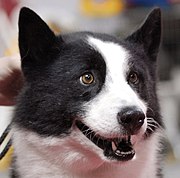
Proper socialization and training is necessary as these dogs demand proper authority and respect to work well with their master and other animals. Treating them harshly will cause them to mistrust so one must be firm but careful when working with them. They must have a trusting and obedient master/dog relationship for everyone's safety.
They must always hunt only with their master and it is best not to have more than two Karelians hunting together or they will either go off hunting on their own or fight over the prey. They work better with other Karelians with which they are raised.
They are silent but tenacious hunters and only alert when they have the prey at bay. They will keep it there by barking in a very high, fast bark and running back and forth or around the animal until the master comes and kills it. They have been known to hold an animal at bay a very long time. If a bear tries to leave the dog will bite it on the backside and aggravate it to keep it from running away.
They are extremely loyal to their master and love their people. For this reason, they must be around them. They also love children and love to play. It is very unusual for a KBD to bite a human but they will kill another animal if they feel threatened. If more than one lives together there is a hierarchy in the pack much like wolves. One will be the alpha dog or leader and the others will usually defer to him/her.
This is not a dog that can be tied to a lead outside, kept in an apartment or never worked with. They are very social, outside hunting dogs and they need plenty of space to run free and get lots of exercise. If they get bored they will dig up the yard or try to get out to go hunting. These traits tend to prevent the breed from becoming popular companion dogs.
They are very territorial and will alert their master to the presence of any strangers or other animals nearby that they do not know.(Wikipedia)
Kangal Dog Best Turkey Dogs
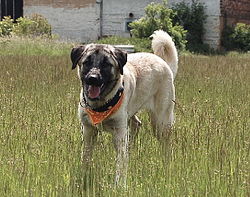
The Sivas Kangal Dog is a breed of domestic dog (Canis lupus familiaris), and is the national breed of Turkey. This dog, which can grow as large as 120 pounds (64 kg), was originally used as a Livestock guardian dog. It is of an early mastiff type with a solid, pale tan or sabled coat, and with a black mask; indeed, another name for the breed is Karabash which translates into black head.
The breed is often referred to as a sheep dog, but it does not herd its charges. Instead, it is developed to live with the flock and act as a livestock guardian dog, fending off wolves, bears and jackals. The Kangal Dog's protectiveness and gentleness with small children and animals has led to its growing popularity as a guardian for families as well, as it watches members of its flock with extreme devotion.
Adult males stand about 28 inches (75 cm) high at the shoulders and weigh about 120 lb (60 kg). females are usually significantly smaller and less heavy in build. Puppies weigh nearly 1 lb (900 g) at birth and by the time they reach seven weeks they are likely to reach 6 lb (10 kg). The Kangal Dog is less heavily built than most other mastiff breeds, allowing them to give chase at speeds of up to 28 miles (50 km) per hour. The Kangal has a short, double layered coat made up of very dense underfur covered by longer and coarser hair. The under-layer provides insulation for both severe Anatolian winters and against the fierce summer sun, while the outer-layer repels water and snow
The ideal Kangal dogs should be calm, controlled, independent, and protective. They may be aloof towards strangers, but a well-socialized Kangal Dog is friendly with visitors and especially children. They must never be shy or vicious. A well-trained Kangal is sensitive and alert to changing situations, responding to threats with judicious warnings and courageous action if necessary. They make good guardians of livestock and humans alike, but they may not be suitable for inexperienced dog owners, as the independent intelligence of the Kangal makes for a difficult pupil.(Wikipedia)
Kai Ken Top Japan Dogs

The Kai Ken (甲斐犬, also called the Tora Inu or Tiger Dog?) is a breed of dog that hails from Japan where it is a national treasure and has been bred for centuries. It is an extremely rare dog even in its native land and is related to the Spitz dog type.
The Kai Ken is a medium sized dog with a wedge shaped head and prick ears. Males are typically 18 to 22 inches at the shoulder, while the females are slightly smaller, 17 to 20 inches at the shoulder. The tail may be curled over the back, or carried in a sickle position. Limbs should be strong and hocks should be well developed reflecting the dogs’ history of mountain life. The coat is of harsh texture, medium length, and black or brindle in color. Its coat could be red or black at the "background". The red is the Aka-tora, the black is the Kuro-tora and between them, the Chu-tora.
The Kai Ken is intelligent, agile, alert and brave. They are naturally hunters and make good guard dogs, being reserved with strangers but loyal to their families. They are friendly, often good with children and are not usually aggressive towards other dogs.(Wikipedia)



